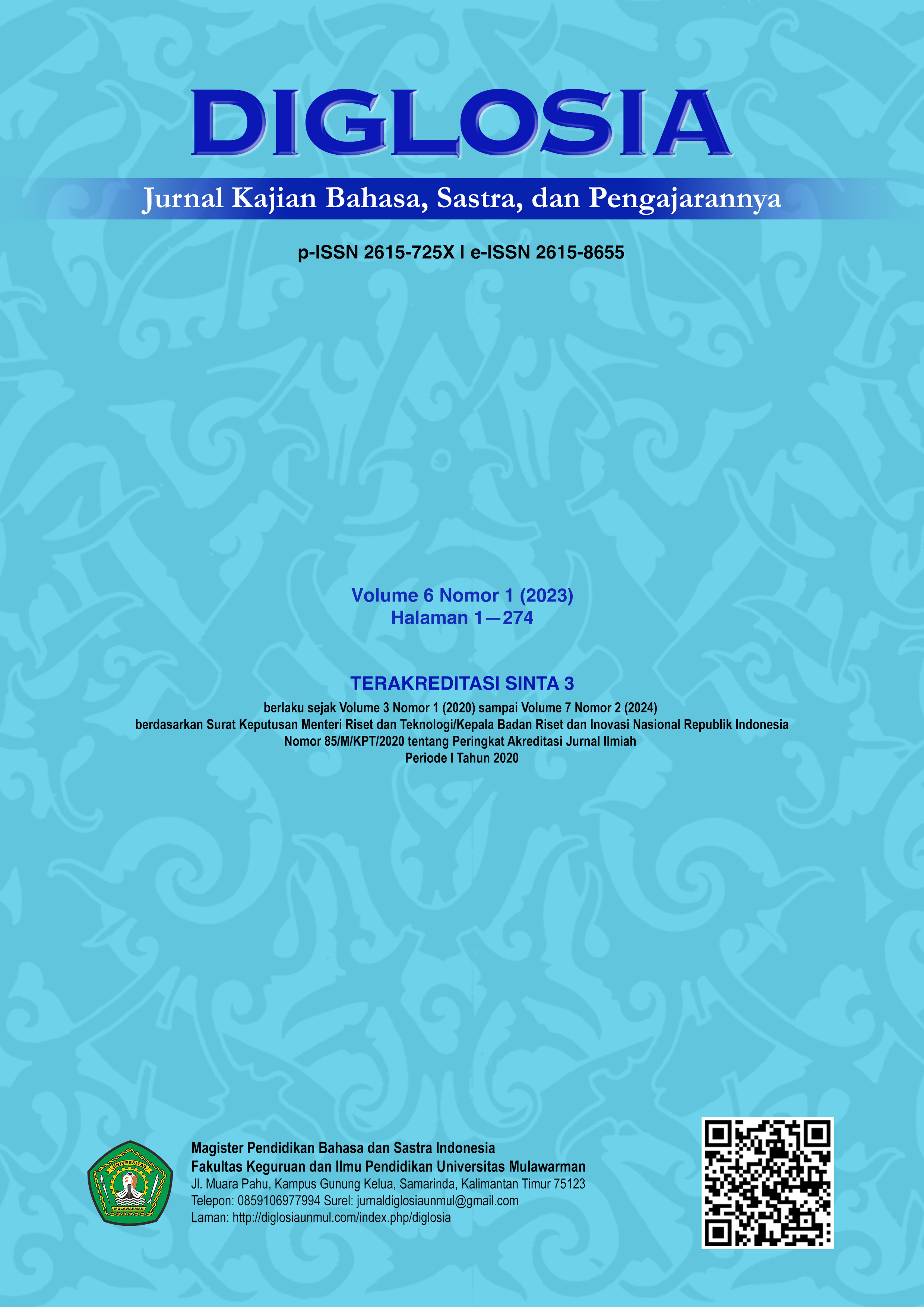Gangguan Aspek Morfologis dan Sintaksis pada Penderita Disleksia Usia 13 Tahun
Main Article Content
Abstract
This study aims to describe the form of language disorders in morphological and syntactic aspects in dyslexic patients aged 13 years. This research is qualitative descriptive research. The subject of this research is a 13-year-old dyslexic with the initials SR, a junior high school student. Data collection techniques with test techniques with written tests to the subject, including a random sentence compilation test and a picture-telling test. The first test amounted to 10 items whose sentence content adjusted Indonesian language learning at the subject's school level. The results of this study show that two aspects of language are disrupted in dyslexic children, namely morphological and syntactic aspects. Morphological aspects include letter addition, letter removal, letter writing errors, letter replacement, letter placement in reverse, removal-replacement, and removal-addition. One of the effects of dyslexia on morphological ability is that SR cannot write words well. On the other hand, syntactic aspect errors include function structure in compound sentences, imperative sentence structure errors, structure errors in procedure sentences, and omission of predicates. From the errors made by SR, it can be proven that SR tends to reverse the sentence structure due to the difficulty in stringing words together.
Downloads
Article Details
![]()
Every work in Diglosia: Jurnal Kajian Bahasa, Sastra, dan Pengajarannya is licensed under a Creative Commons Attribution-ShareAlike 4.0 International License.
Under the following terms:
- Attribution — You must give appropriate credit , provide a link to the license, and indicate if changes were made . You may do so in any reasonable manner, but not in any way that suggests the licensor endorses you or your use.
- ShareAlike — If you remix, transform, or build upon the material, you must distribute your contributions under the same license as the original.
- No additional restrictions — You may not apply legal terms or technological measures that legally restrict others from doing anything the license permits.
Authors who publish with this journal agree to the following terms:
- Authors retain copyright and grant the journal right of first publication with the work simultaneously licensed under a CC BY-SA 4.0 DEED Attribution-ShareAlike 4.0 Internationalthat allows others to share the work with an acknowledgment of the work's authorship and initial publication in this journal.
- Authors are able to enter into separate, additional contractual arrangements for the non-exclusive distribution of the journal's published version of the work (e.g., post it to an institutional repository or publish it in a book), with an acknowledgment of its initial publication in this journal.
- Authors are permitted and encouraged to post their work online (e.g., in institutional repositories or on their website) prior to and during the submission process, as it can lead to productive exchanges, as well as earlier and greater citation of published work.
References
Djamarah, S. B. (2002). Psikologi Belajar. Rineka Cipta.
Fahreza, F. C. D. (2019). Analisis Bahasa Tulisan pada Anak dengan Gangguan Disleksia (Pendekatan Psikolinguistik). Metamorfosis, 12(2), 45–50. https://ejournal.unibba.ac.id/index.php/metamorfosis/article/view/228
Haifa, N., Mulyadiprana, A., & Respati, R. (2020). Pengenalan Ciri Anak Pengidap Disleksia. Pedadidaktika: Jurnal Ilmiah Pendidikan Guru Sekolah Dasar, 7(2), 21–32. https://ejournal.upi.edu/index.php/pedadidaktika/article/view/25035
Indah, R. N. (2017). Gangguan Berbahasa: Kajian Pengantar. UIN-Maliki Press. http://repository.uin-malang.ac.id/1296/6/1296.pdf
Lidwina, S. (2012). Disleksia Berpengaruh pada Kemampuan Membaca dan Menulis. Jurnal STIE Semarang, 4(3), 9–17. https://media.neliti.com/media/publications/132465-ID-disleksia-berpengaruh-pada-kemampuan-mem.pdf
Miles, M. B., & Huberman, A. M. (1992). Analisis Data Kualitatif: Buku Sumber tentang Metode Metode Baru. Penerbit Universitas Indonesia.
Nurjan, S. (2016). Psikologi Belajar. Wade Group.
Permatasari, N. E., Khasanah, I. M., & Putri, N. A. M. (2019). Kesalahan Berbahasa dalam Majalah Pandawa IAIN Surakarta Edisi 2018 pada Tataran Ejaan dan Sintaksis. Diglosia: Jurnal Kajian Bahasa, Sastra, Dan Pengajarannya, 2(2), 103–114. https://doi.org/10.30872/diglosia.v2i2.22
Radityayu. (2020). No Title. https://www.instagram.com/p/B_-tX2TgfE4/
Ramlan, M. (2005). Ilmu Bahasa Indonesia: Sintaksis. Karyono.
Ramlan, M. (2012). Morfologi: Suatu Tinjauan Deskriptif. Karyono.
Rismaya, R., Wahya, W., & Lukman, F. (2022). Kata Bahasa Indonesia Penanda Register Twitter: Suatu Kajian Morfologi. Diglosia: Jurnal Kajian Bahasa, Sastra, Dan Pengajarannya, 5(2), 511–526. https://doi.org/10.30872/diglosia.v5i2.411
Saadah, V. N., & Hidayah, N. (2015). Pengaruh Permainan Scrabble terhadap Peningkatan Kemampuan Membaca Anak Disleksia. Empathy, 1(1), 39–52. https://doi.org/10.12928/empathy.v1i1.3000
Sari, M. N. (2019). Kesalahan Penulisan pada Anak Disgrafia di Sekolah Inklusif Galuh Handayani Surabaya: Kajian Psikolinguistik [Universitas Airlangga]. https://repository.unair.ac.id/86128/
Subyantoro. (2013). Gangguan Berbahasa: Mengenal untuk Mengantisipasi Sejak Dini. Ombak.
Syahroni, I., Rofiqoh, W., & Latipah, E. (2021). Ciri-Ciri Disleksia pada Anak Usia Dini. Jurnal Buah Hati, 8(1), 62–77. https://doi.org/10.46244/buahhati.v8i1.1326
Tarigan, H. G. (2015). Keterampilan Membaca (H. G. Tarigan (ed.); Revisi). Penerbit Angkasa, Bandung-Indonesia.
Utami, S. P., & Irawati, L. (2017). Bahasa Tulis pada Anak dengan Gangguan Disleksia (Kajian Psikolinguistik). Linguista, 1(1), 23–29. https://doi.org/10.25273/linguista.v1i1.1315
Verhaar, J. V. M. (2016). Asas-Asas Linguistik Umum. Gadjah Mada University Press.
Zulharby, P., Rafli, Z., & Setiadi, S. (2022). Interferensi Morfologi Bahasa Pertama terhadap Keterampilan Berbicara Bahasa Arab. Diglosia: Jurnal Kajian Bahasa, Sastra, Dan Pengajarannya, 5(4), 749–762. https://doi.org/10.30872/diglosia.v5i4.510

